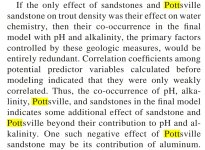Hi Dave.. As one crusty old pfart to another, I hope all is well w/you....🙂 I agree with much of what you say here, but would note that evidently in keeping with PFBC's current direction on reducing the stocking of catchable ST, more BT and RT are being stocked in waters that previously received only ST. Among these are Blue Jay, Queen, The Branch and a portion of Salmon Creek. They are still though, stocking a significant number of ST in comparison with other regions of the state, a situation I am sure is related to low baseline Ph's as you suggest.
I also agree, as you suggest, that left alone, many of the currently stocked ANF stream sections, particularly in Forest and Elk Counties would be dominated by wild ST. The thing though, as I see it, is that in a lot of these cases, the result would not be a wild ST fishery that has improved much if at all from where it was when the stream was stocked. I knows this runs counter to the current orthodoxy here about the primary nature of the suppressive effects of stocking on wild ST pops. My belief though is that, due to geology and the resulting fertility issues as well as disturbance from extration activities, etc., a significant number of the wild ST pops in currently stocked ANF stream sections are more incidental than viable and would be unlikely to improve enough to notice in the event stocking were curtailed.
I'm fine and get along now as well as I did 20 years ago. Aches and pains, but I've always had that and learned to live with it.
As far as the rest of what you wrote, I'm sure you realize I can't argue with most of it. But what exactly is viable? Class A? Class B. What?
Years ago... I think it was late 70s, I used to fish Tom's run in Cook Forest. I've told this story before, but I'll tell it again. Forgive me. By the late 70s, It had improved from years of abuse, and some natural issues to the point that it held brook trout again without the help of stocking. I even participated in some stream improvement in the lower parts in 76. Most people didn't know this at the time that brook trout had returned. I work for the park in 78 (summer job) and would hit Toms after work, and sometimes even during my lunch break. Oh sure, people knew that it held minnows, but that's about it. People would stop and ask what I was fishing for. Stock answer is just killing time.
On one of those days, I hit a small section of Tom's run near one of the pavilions during my lunch break. Caught a handful of natives, and even caught one that was at least 10 inches, just above the bridge on the road to Vowinkle. Was my biggest to date. I decided I would hit the same stretch again after work. When I did, all I caught were stocked brook trout. What the... The next day I asked around and found out that the PFBC secretly stocked 50 brook trout in that section to see how they would do. The following years, they started stocking the hell out of it from Brown Run to the river. I still fished it for the next few years, but the wild trout became few and far between. Lots of stocked trout, but I caught very few natives unless I walked to the confluence of Brown Run. Above that, Tom's run was still considerably impaired, but Brown run diluted it enough that trout had returned to Toms from the Brown Run and other tribs where they were all along.
Nobody can convince me that if they stopped stocking Tom's run that it wouldn't be a viable brook trout fishery. It wouldn't be a Class A. More than likely a class C. Back in the late 70s, it was probably a class D. Viable is in the eye of the beholder. For a person who only knows to use PFBC published lists, it would not be viable nor would many of the streams in the ANF. To those of us who don't rely on lists...
Disclaimer: Although we likely never met, I have known you through this site for many years. I respect you, and know that you are an avid fisherman who doesn't need lists. Most of what I said above is not directed at you. Your post simply inspired it.
Class A means very little in that area. The streams simply can't handle that much biomass all year long.








